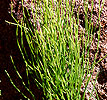 |
 |
|
|
|
(Return to Family List)
There is only one genus in this family&emdash;Equisetum, the horsetails and scouring rushes. All members look similar with hollow, green, grooved and jointed stems, whorled branches and microphyll leaves (reduced to a whorl of teeth united into a sheath around the stem joints). The cell walls of Equisetum are filled with silicon dioxide (essentially sand), making the plants very tough and abrasive, which is how they got the common name scouring rushes.
The fertile stems may look similar to or different from sterile stems. All Equisetaceae reproduce by spores dispersed from sporangia at the stem tips, have a free-living gametophyte generation that produces gametes, and require water for fertilization.
Equisetaceae are often found in relatively wet habitats, but they can also be found in apparently dry habitats such as railroad embankments. Some species of Equisetum (e.g., E. arvense) become pests (look around Ruston) and are extremely difficult to eradicate once established. This difficulty arises from the rather deep underground rhizome of most species of Equisetum and from their ability to establish a new plant from a vegetative fragment. Each node is capable of producing branches (stems) and roots, so any fragment left on moist ground is capable of starting a new clone.
 |
 |
|
|
|